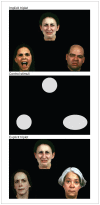Orbitofrontal volume reductions during emotion recognition in patients with major depression
- PMID: 20569645
- PMCID: PMC2928284
- DOI: 10.1503/jpn.090076
Orbitofrontal volume reductions during emotion recognition in patients with major depression
Abstract
Background: Major depressive disorder is associated with both structural and functional alterations in the emotion regulation network of the central nervous system. The relation between structural and functional changes is largely unknown. Therefore, we sought to determine the relation between structural differences and functional alterations during the recognition of emotional facial expressions.
Methods: We examined 13 medication-free patients with major depression and 15 healthy controls by use of structural T1-weighted high-resolution magnetic resonance imaging (MRI) and functional MRI during 1 session. We set the statistical threshold for the analysis of imaging data to p < 0.001 (uncorrected).
Results: As shown by voxel-based morphometry, depressed patients had reductions in orbitofrontal cortex volume and increases in cerebellar volume. Additionally, depressed patients showed increased activity during emotion recognition in the middle frontal cortex, caudate nucleus, precuneus and lingual gyrus. Within this cerebral network, the orbitofrontal volumes were negatively correlated in depressed patients but not in healthy controls with changes in blood oxygen level-dependent signal in the middle frontal gyrus, caudate nucleus, precuneus and supplementary motor area.
Limitations: Our results are limited by the relatively small sample size.
Conclusions: This combined functional and structural MRI study provides evidence that the orbitofrontal cortex is a key area in major depression and that structural changes result in functional alterations within the emotional circuit. Whether these alterations in the orbitofrontal cortex are also related to persistent emotional dysfunction in remitted mental states and, therefore, are related to the risk of depression needs further exploration.
Figures



Similar articles
-
Reversed frontotemporal connectivity during emotional face processing in remitted depression.Biol Psychiatry. 2012 Oct 1;72(7):604-11. doi: 10.1016/j.biopsych.2012.04.031. Epub 2012 Jun 6. Biol Psychiatry. 2012. PMID: 22682158 Free PMC article.
-
Functional connectivity of emotional processing in depression.J Affect Disord. 2011 Nov;134(1-3):272-9. doi: 10.1016/j.jad.2011.06.021. Epub 2011 Jul 14. J Affect Disord. 2011. PMID: 21757239
-
Functional connectivity bias of the orbitofrontal cortex in drug-free patients with major depression.Biol Psychiatry. 2010 Jan 15;67(2):161-7. doi: 10.1016/j.biopsych.2009.08.022. Biol Psychiatry. 2010. PMID: 19811772
-
Brain activation during processing of genuine facial emotion in depression: Preliminary findings.J Affect Disord. 2018 Jan 1;225:91-96. doi: 10.1016/j.jad.2017.07.049. Epub 2017 Jul 27. J Affect Disord. 2018. PMID: 28802727 Review.
-
Brain Structural Effects of Antidepressant Treatment in Major Depression.Curr Neuropharmacol. 2015;13(4):458-65. doi: 10.2174/1570159x1304150831121909. Curr Neuropharmacol. 2015. PMID: 26412065 Free PMC article. Review.
Cited by
-
Lifetime major depression and grey-matter volume.J Psychiatry Neurosci. 2019 Jan 1;44(1):45-53. doi: 10.1503/jpn.180026. J Psychiatry Neurosci. 2019. PMID: 30565905 Free PMC article.
-
Individual differences in threat and reward neural circuitry activation: Testing dimensional models of early adversity, anxiety and depression.Eur J Neurosci. 2022 May;55(9-10):2739-2753. doi: 10.1111/ejn.15592. Epub 2022 Jan 19. Eur J Neurosci. 2022. PMID: 34989038 Free PMC article.
-
Insular and hippocampal gray matter volume reductions in patients with major depressive disorder.PLoS One. 2014 Jul 22;9(7):e102692. doi: 10.1371/journal.pone.0102692. eCollection 2014. PLoS One. 2014. PMID: 25051163 Free PMC article.
-
Bidirectional Control of Emotional Behaviors by Excitatory and Inhibitory Neurons in the Orbitofrontal Cortex.Exp Neurobiol. 2024 Oct 31;33(5):225-237. doi: 10.5607/en24021. Exp Neurobiol. 2024. PMID: 39568179 Free PMC article.
-
High-field magnetic resonance imaging of structural alterations in first-episode, drug-naive patients with major depressive disorder.Transl Psychiatry. 2016 Nov 8;6(11):e942. doi: 10.1038/tp.2016.209. Transl Psychiatry. 2016. PMID: 27824357 Free PMC article.
References
-
- Gotlib IH, Krasnoperova E, Yue DN, et al. Attentional biases for negative interpersonal stimuli in clinical depression. J Abnorm Psychol. 2004;113:121–35. - PubMed
-
- Persad SM, Polivy J. Differences between depressed and nondepressed individuals in the recognition of and response to facial emotional cues. J Abnorm Psychol. 1993;102:358–68. - PubMed
-
- Frodl T, Moller HJ, Meisenzahl E. Neuroimaging genetics: New perspectives in research on major depression? Acta Psychiatr Scand. 2008;118:363–72. - PubMed
-
- Coffey CE, Wilkinson WE, Weiner RD, et al. Quantitative cerebral anatomy in depression. A controlled magnetic resonance imaging study. Arch Gen Psychiatry. 1993;50:7–16. - PubMed
-
- Lacerda ALT, Keshavan MS, Hardan AY, et al. Anatomic evaluation of the orbitofrontal cortex in major depressive disorder. Biol Psychiatry. 2004;55:353–8. - PubMed
Publication types
MeSH terms
LinkOut - more resources
Full Text Sources
Research Materials
